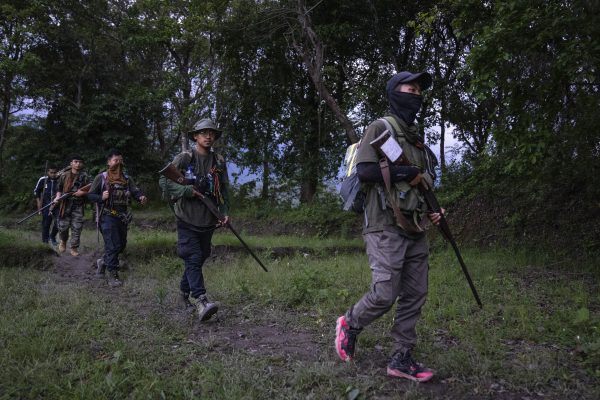Magazine
Tracing the historic roots – and immediate chronology – of the violence in the Northeast Indian state.

Armed tribal Kuki community members patrol near a de facto frontline dissecting the area into two ethnic zones in Churachandpur, in Manipur, India, June 20, 2023.
Credit: AP Photo/Altaf Qadri, File
Manipur – meaning “Land of Jewels” – is the oldest surviving state in Northeast India, tracing its history back to 33 AD. It is composed of a beautiful, lush, green valley that is surrounded by several mountain ranges. During the summer months, its lakes are filled with lotus and lily flowers. The first Indian prime minister, Jawaharlal Nehru, called Manipur the “Switzerland of India.” It is also the state where one of the defining battles of World War II was fought between the Allies and the Axis Powers: the Battle of Imphal, which took place around the state capital from March to July 1944.
Manipur has its own language and script and is recognized around the world as a culturally rich state, including serving as the birthplace of the game of polo. It is currently home to 3.3 million people belonging to 39 ethnic groups and boasts the world’s oldest and strongest women-led political movements.
In spite of this rich tradition, Manipur’s past is excluded from India’s textbooks today, and hence very few people in the country and the world know its deep history. Yet this little-known state is at the epicenter of a violent conflict that erupted in May of this year and continues even as this issue goes to print. Manipur has become one of the world’s least known conflict zones.
Manipur has been colonized four times in its recent history. The first could be termed a “religious colonization.” In the 18th century, Vaishnavism was introduced to Manipur by Shantidas Godsai and forcibly made the state religion. To the present, the people of Manipur remember the burning of the Manipuri Puyas, the manuscripts that were destroyed in order to eliminate any evidence of pre-Vaishnavite Indigenous religious and spiritual traditions.
Diplomat Brief
Weekly Newsletter
Get briefed on the story of the week, and developing stories to watch across the Asia-Pacific.
Get the Newsletter
The second wave of colonization came in the 19th century with the invasion of Manipur by the Burmese kings. Known as the Chahi Taret Khuntakpa, or “Seven Years Devastation,” the invasion took place from 1819 to 1826.
The third colonization happened when the British took over Manipur in 1891 after the Anglo-Manipuri War, and the fourth took place when Manipur was made a part of the independent Union of India on September 21, 1949. Against this backdrop, the violence that erupted in the state on May 3 is seen by many as an attack on Manipur’s distinct identity.
The “merger” of Manipur with India is a topic that Manipuris continue to discuss and debate. After all, Manipur has a long and proud history as an independent state – one with its own constitution, the Loiyumba Shinyen, dating back to the 11th century. In another example, Manipur’s Royal Chronicle, the Cheitharol Kumbaba, documents the history of Manipur, its rulers, and its courts since 33 AD. In 1947, just ahead of India’s independence, Manipur issued its own modern constitution.
While some Manipuris agreed with joining the Union of India, some protested the merger, calling it unconstitutional.

